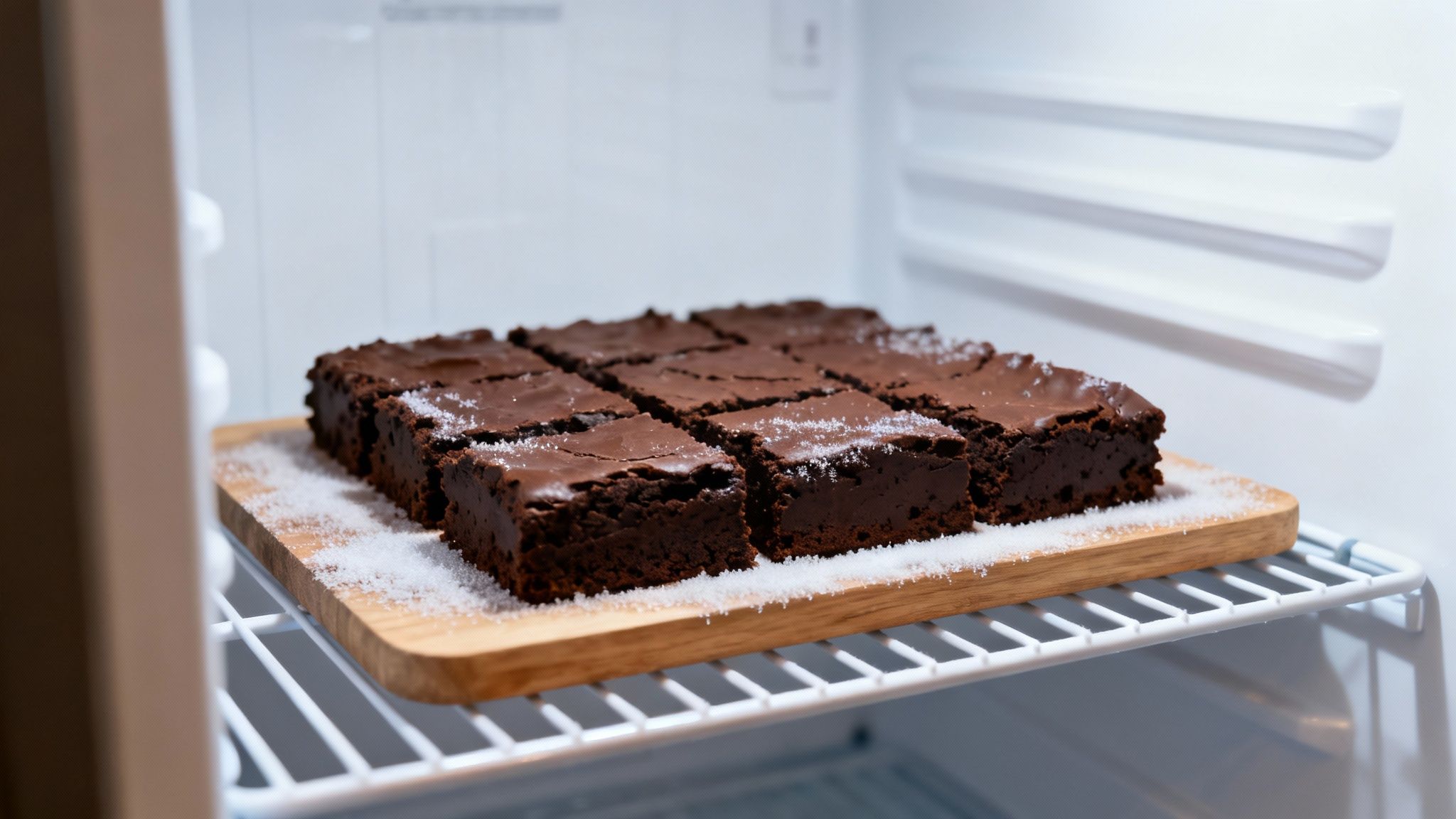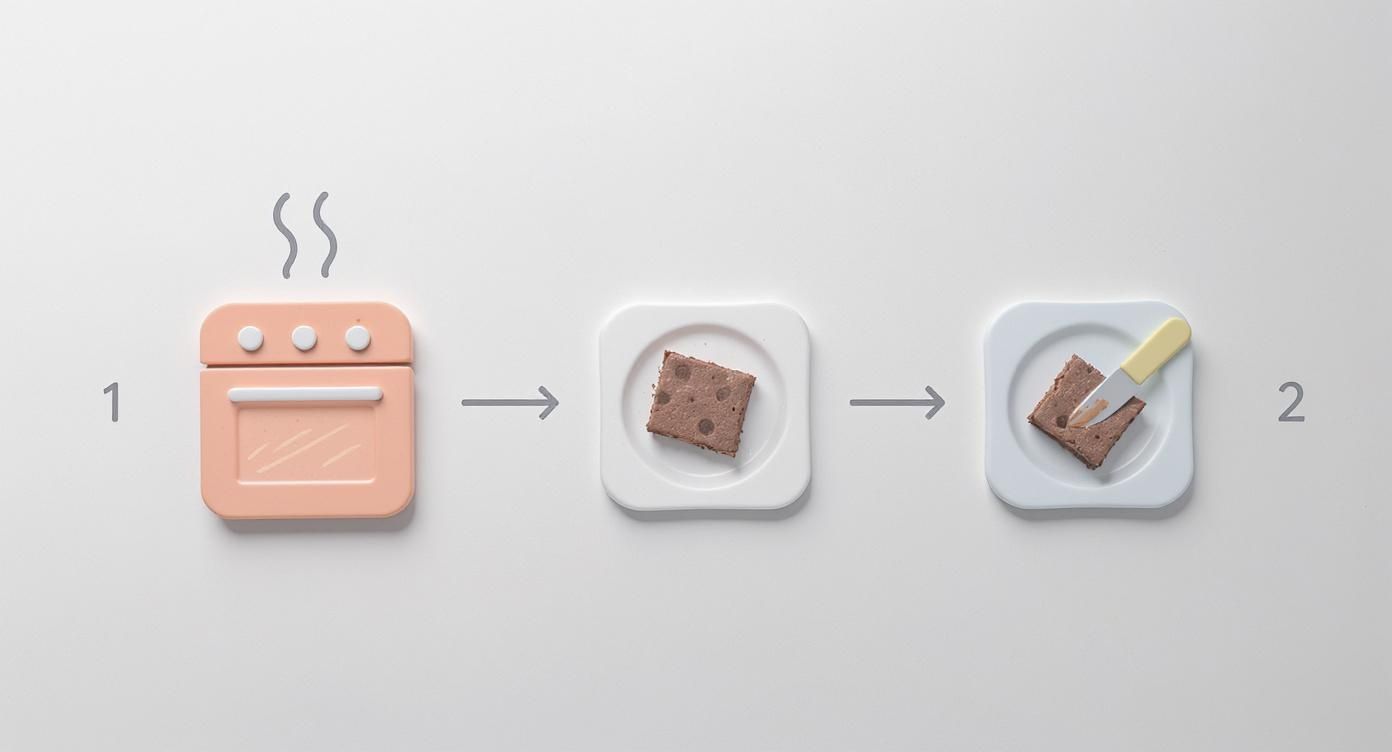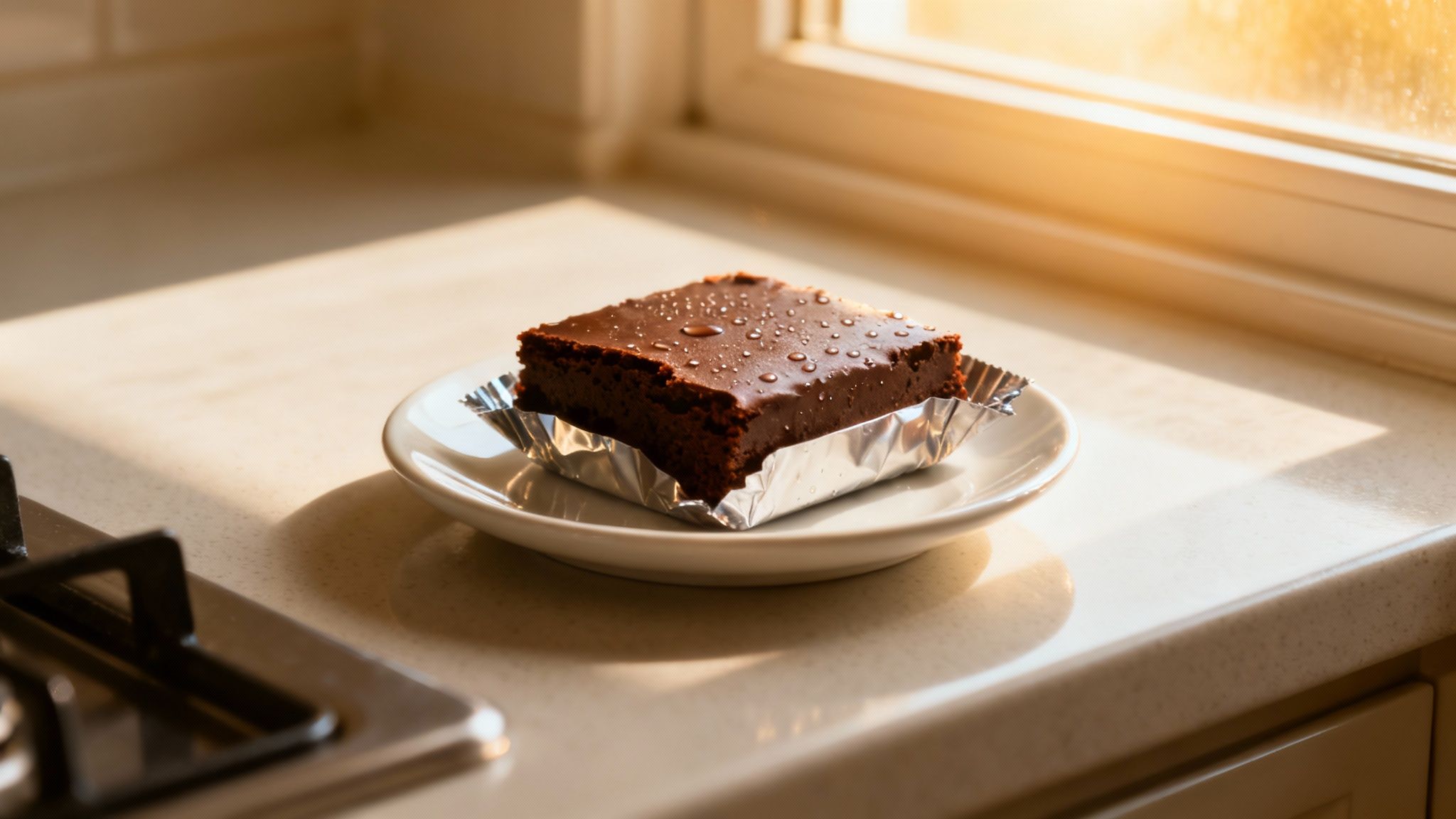How to Freeze Brownies for That Fresh-Baked Taste
Ever bake a flawless batch of fudgy brownies, only to find them dry and stale a day later? We’ve all been there. The secret to avoiding this tragedy is your freezer. Freezing locks in moisture and preserves that just-baked texture for weeks, keeping your decadent treats ready for any occasion.
Why Freezing Is Your Secret Weapon for Perfect Brownies

Learning how to freeze brownies properly isn’t just a long-term storage hack; it’s a strategy for preserving peak freshness. Most fudgy brownie recipes have a high fat and sugar content, which actually makes them incredibly freezer-friendly. These ingredients act as natural preservatives, helping to stop large, texture-ruining ice crystals from forming.
Think of it as hitting the pause button right when your brownies are at their absolute best. Instead of letting them slowly dry out on the counter, you’re capturing all that moisture and flavor instantly. This simple technique transforms your freezer into a personal bakery case, stocked and ready to go.
Keeping Brownies Fresh and Flavorful
The main enemy of a great brownie is air. Exposure to air is what leads to moisture loss and that dreaded stale, crumbly texture. Freezing, when done right, halts this process completely. When you wrap them correctly, your brownies are shielded from the dry freezer environment, ensuring they stay just as delicious as the day you baked them.
The real secret to success is preventing freezer burn. An airtight seal is non-negotiable if you want to maintain that gooey, fudgy interior and crackly top without any weird freezer flavors creeping in.
This method gives you ultimate convenience for pretty much any situation:
- Effortless Party Prep: Bake a huge batch weeks ahead of your event for totally stress-free hosting.
- Perfect Portion Control: Freeze individual squares for a quick single-serving dessert whenever a craving strikes.
- Reduced Food Waste: Save those last few delicious leftovers from going stale by stashing them for later.
The demand for high-quality, convenient baked goods is booming. The global frozen bakery products market hit an incredible $30.23 billion in 2024 and is projected to grow significantly. This growth is driven by people like us who want delicious, ready-to-eat foods without sacrificing quality. You can read more about the frozen bakery market growth to see how the pros use these same techniques.
Freezer vs. Counter At a Glance
So, when should you freeze versus just leaving them on the counter? Here’s a quick look at how freezing stacks up against countertop storage for keeping brownies fresh and delicious.
| Attribute | Freezing Method | Countertop Storage |
|---|---|---|
| Freshness | Locks in peak freshness for weeks | Starts losing moisture after 1-2 days |
| Texture | Preserves fudgy, gooey texture | Can become dry and crumbly quickly |
| Flavor | Retains rich, chocolatey flavor | Flavor can fade or taste stale |
| Convenience | Grab-and-go treats anytime | Best for immediate consumption |
| Best For | Long-term storage, portion control | Serving within 48 hours of baking |
Ultimately, freezing is the clear winner for anyone who wants to enjoy perfect brownies long after they’ve cooled from the oven.
The First Crucial Step Before You Freeze
The secret to a perfectly preserved brownie begins the moment it leaves the oven, long before it ever sees the inside of a freezer. Before you even reach for the plastic wrap, the single most important thing you can do is let your brownies cool completely. This isn’t just a casual tip; it’s the absolute foundation for freezing brownies without wrecking their texture.
Think about it: even a slightly warm brownie is still releasing steam. If you trap that steam inside a wrapper, it turns into moisture, which then becomes a layer of ice crystals in the freezer. Those ice crystals are the mortal enemy of a fudgy, dense brownie, guaranteeing a gritty, watery mess when you thaw it out. A little patience here pays off big time later.
To Cut or Not to Cut
Once your brownies have cooled to room temperature, you’ve got a choice to make. Do you freeze the whole slab, or do you slice it into individual squares? There’s no wrong answer here—it really just depends on how you plan to eat them down the road.
- Freezing a Whole Slab: This is your best bet for preventing moisture loss and keeping the edges from drying out. It’s the perfect move if you know you’ll be serving the entire batch for a party or family get-together.
- Freezing Individual Squares: If you’re all about convenience and want a quick, single-serving treat ready to grab, pre-cutting is the way to go. This method is amazing for portion control and satisfying those sudden chocolate cravings.
Think of it like meal prepping. Freezing the whole slab is like making a big casserole for a future event. The individual squares are your grab-and-go snacks for the week. Both methods work beautifully as long as you do them right.
It also helps to understand how different ingredients hold up in the freezer. The science behind preserving a rich, fatty dessert isn’t all that different from a savory dish. We explore a similar concept in our guide on if you can freeze baked macaroni and cheese, where the fat content is key to maintaining quality.
At the end of the day, fudgy brownies almost always freeze better than cakey ones. Their high fat and butter content acts as a natural shield against the freezer’s drying effects, so they emerge just as rich and decadent as the day you baked them. Cakey brownies, with their lighter, airier structure, are just more likely to become dry and crumbly after a stint in the cold.
Mastering the Art of Airtight Wrapping
Improper wrapping is the number one enemy of a perfectly frozen brownie. It’s the main culprit behind freezer burn, that dreaded foe that leaves dry, discolored patches and a stale, unpleasant taste. To win this battle, you need to create a completely airtight barrier that locks out air and moisture.
This is where the foolproof double-wrapping technique comes in. It’s your most valuable tool for getting this right.
The First Line of Defense: Plastic Wrap
Your first move is to create a skin-tight seal. Grab some high-quality plastic wrap and tightly cover each individual brownie square (or the whole slab, if you’re freezing it that way). The goal here is to make the plastic cling to every single surface, pushing out any trapped air pockets before you finish wrapping.
This initial layer is absolutely critical. It’s what stops ice crystals from forming directly on the brownie itself, preserving that perfect, fudgy texture.
This diagram lays out the essential flow before you even touch a roll of plastic wrap.

As you can see, properly cooling and cutting the brownies are foundational steps. Get those wrong, and your wrapping efforts won’t be nearly as effective.
Adding a Second Layer of Protection
With the first layer secure, it’s time for backup. This second wrap provides a more durable shield, protecting your brownies from absorbing any weird odors from other foods in your freezer and offering another barrier against the harsh, cold air.
For this second layer, you’ve got a couple of great options:
- Heavy-Duty Aluminum Foil: This is my go-to. Wrap the plastic-covered brownies tightly in a sheet of foil. It molds easily and adds a sturdy, moisture-proof layer that really holds up.
- Freezer-Safe Zip-Top Bags: Alternatively, you can slide the plastic-wrapped brownies into a heavy-duty freezer bag. Just make sure to press out as much excess air as you can before sealing it shut.
This two-step process is incredibly effective. The plastic wrap provides the critical airtight seal against the brownie, while the foil or freezer bag offers robust, long-term protection. It’s the same principle we use for locking in freshness with produce, which we cover in our guide on how to freeze fresh zucchini.
Pro Tip: If you’re stacking individually wrapped brownies in a freezer bag, place a small sheet of parchment or wax paper between each layer. This simple trick is a game-changer—it prevents them from freezing into one giant, sad brownie block and keeps them from getting squished.
How to Store and Label for Best Results
You’ve gone to all the trouble of wrapping your brownies perfectly. Now, where you stick them in the freezer matters more than you might think. Don’t just toss them in wherever there’s an open spot.
Find a flat, stable place where they won’t get squashed by a rogue bag of frozen peas or a Thanksgiving turkey. I like to stack mine neatly in a container or a dedicated drawer. This simple move protects them from getting crushed, which could break that airtight seal you just created. An organized freezer isn’t just about neatness—it’s about protecting your hard work.
Stay Away From the Freezer Door
Whatever you do, keep your wrapped brownies far away from the freezer door. This is the warmest part of the appliance, and the temperature swings wildly every time you open it for a late-night ice cream run.
Those constant temperature shifts cause your brownies to partially thaw and refreeze over and over. That’s a recipe for disaster, as it encourages ice crystals to form and completely ruins that perfect texture. For the best results, tuck them into the back or the middle of the freezer where the temperature stays nice and steady.
Your goal is a consistent, deep freeze. Storing them deep inside the freezer keeps them completely frozen until you’re ready, locking in that ideal fudgy texture you’re trying to preserve.
Don’t Skip the Label
Last but not least, label everything. I know it seems like a pain, but this step is non-negotiable and literally takes ten seconds. Grab a marker and some tape or a freezer-safe label.
All you need is the type of brownie (e.g., ‘fudge walnut’) and the date you froze it. This little habit ensures you eat them within their peak quality window, which is around three months for the best possible flavor and texture.
This is the same logic that drives the massive packaged brownie market, which is projected to hit $5.96 billion by 2031. People want treats that last. By following these steps, you’re basically using pro-level techniques at home. You can actually discover more about packaged brownie market trends to see how your home freezing methods stack up against the big guys.
The Right Way to Thaw Your Frozen Brownies

You did the hard part—baking and freezing your brownies perfectly. Now comes the final, crucial step: thawing them without ruining that incredible texture. How you defrost your brownies makes all the difference between a fudgy, delicious treat and a soggy disappointment.
Luckily, the absolute best method is also the easiest one.
Just pull your wrapped brownies from the freezer and let them sit on the counter for a few hours. The trick is to leave them in their wrapping until they’ve reached room temperature. Seriously, don’t touch the plastic wrap.
This simple step ensures any condensation forms on the outside of the wrapping, not on the brownie itself. As they thaw, the brownies reabsorb any trapped moisture, which is the secret to keeping them dense and fudgy. Managing moisture is a core principle of food preservation, something we also cover in our guide on whether chili freezes well.
Quick Thawing Methods for Sudden Cravings
Let’s be real—sometimes you just can’t wait a few hours. When a chocolate craving strikes and you need a brownie now, you have a couple of faster options to bring that frozen square back to life.
- The Microwave Method: Unwrap a brownie and pop it on a microwave-safe plate. Heat it on a low power setting in 10- to 15-second bursts until it’s just warmed through. Be careful here; short intervals are key to preventing the brownie from overcooking and turning into a rubbery puck.
- The Toaster Oven Trick: For that amazing “freshly baked” taste, unwrap your frozen brownie and place it in a toaster oven at 300°F (150°C) for about 5-10 minutes. This gently warms it, reactivating the chocolate for an irresistibly warm, gooey center.
The demand for high-quality frozen desserts is bigger than ever. In fact, the global market for just one item, Frozen Brownie Sundae Cups, is expected to hit $2.67 billion by 2033. It just goes to show how much people value a perfectly preserved, ready-to-enjoy treat. You can find more insights on the rise of frozen desserts on marketintelo.com.
Your Top Brownie Freezing Questions, Answered
Even after years in the kitchen, freezing baked goods can feel like a bit of a gamble. Will they taste the same? What about the frosting? We get it. Here are the answers to the most common questions that pop up when you’re trying to perfectly preserve your brownies.
Can I Freeze Brownies with Frosting or Ganache?
You absolutely can, but there’s one little trick you need to know. Frostings with a high fat content, like cream cheese frosting and rich chocolate ganache, freeze beautifully. The key is to prevent the wrapping from smooshing your beautiful topping.
To do this, you’ll want to “flash freeze” them. Just place the frosted brownies on a baking sheet, uncovered, and pop them in the freezer for about an hour. Once the frosting is firm to the touch, you can go ahead and wrap them using the double-wrapping method without making a mess.
What about buttercream? It can work, but sometimes the texture changes a bit upon thawing—it might separate slightly. The flash-freezing step is non-negotiable here to keep it from smearing everywhere.
How Long Do Frozen Brownies Really Last?
For the best possible taste and that perfect fudgy texture, you’ll want to eat your frozen brownies within three months.
Sure, they’ll probably be safe to eat for a little longer, but you risk them developing freezer burn or losing that deep, chocolatey flavor that makes them special. Sticking to that airtight, double-wrapping technique is your best defense for hitting that three-month sweet spot with quality to spare.
What Are the Telltale Signs My Frozen Brownies Have Gone Bad?
Your eyes and nose are the best tools here. The most obvious sign is significant freezer burn, which looks like dry, grayish, or discolored patches across the brownie’s surface. A thick blanket of ice crystals is another bad sign.
Once thawed, a brownie that’s past its prime will taste stale or have a tough, unpleasantly dry texture. And, of course, if you notice any strange or off smells, don’t even think about it—just toss them.
Your senses are your best guide. If a brownie looks or smells off after thawing, it’s always better to be safe and toss it out.
Is It Better to Freeze Brownies Whole or Cut?
This one comes down to how you plan to serve them later. There’s no right or wrong answer, just different strategies.
Freezing the entire slab of brownies whole is fantastic for locking in moisture. It’s the ideal move if you know you’ll be serving the whole batch at once for a party or family gathering.
On the other hand, freezing individual squares is a game-changer for portion control and grab-and-go treats. You can just thaw exactly what you need, when you need it. As long as you wrap them properly, both methods work like a charm.





